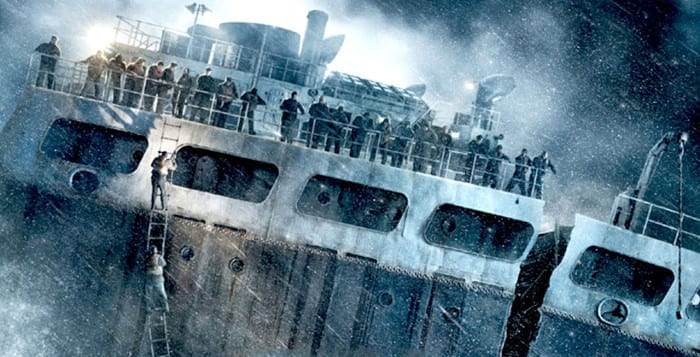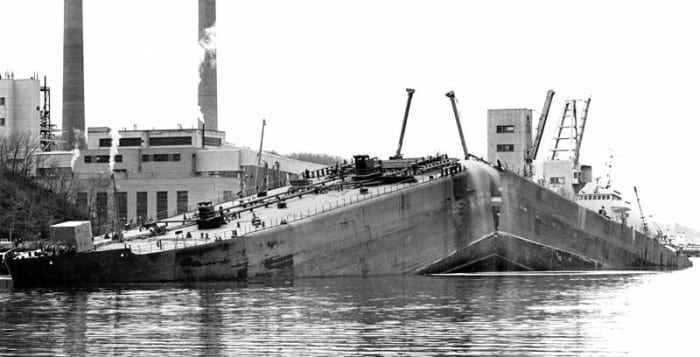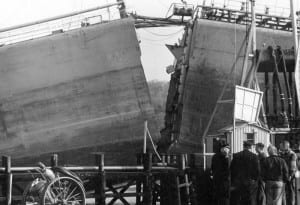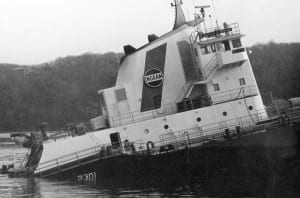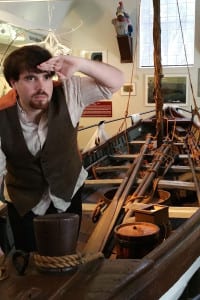Once upon a time, throughout the 19th century, if one looked down into Port Jefferson Harbor, one could see the tall masts of sailing ships rising high above the surrounding buildings, in a place once called Drowned Meadow.
Nowadays, the harbor is home to many small vessels, but a new, 118-foot schooner could soon dwarf them if plans to bring in a handcrafted ship built in Maine come to fruition.
Captain George “Butch” Harris, the owner of the Halie & Matthew, a 118-foot-long, gaff-rigged, fiberglass ship, is currently in talks with the Village of Port Jefferson over establishing the harbor as its residence. The village board voted to allow Mayor Margot Garant to try and set up an agreement with the ship’s owner.
If an agreement is reached, the schooner would be moored along the dock in front of Harborfront Park, on the other side of Stony Brook University’s Seawolf research vessel.
“We’ve been looking for a long time to have a schooner call us home,” Garant said during a March 18 board meeting.
According to a draft proposal given to Port Jefferson by Maine Windjammers Inc., the ship would be used free for the village and Port Jefferson Harbor Education and Arts Conservancy as a promotional platform. The village would agree to promote the Halie & Matthew as the village’s “home schooner,” to pay for electric, water and dock maintenance and guarantee exclusive space at the dock for four years.
The conservancy set up a Tall Ship Committee more than a year ago in an effort to get a sizable ship into Port Jefferson Harbor. Harris said he comes from a family of shipbuilders, his father owning a boat shop that he worked in as a kid. He started work on the Halie & Matthew in 2001 and finished in 2006. Since then the ship has sailed as far south as Florida and as far north as Canada.
Jason Rose, a member of the committee, is breathless with excitement over the prospect of a tall ship sitting in the harbor. Himself an avid sailor, he is currently working with The Boat Place in Port Jeff to revitalize his own 42-foot schooner, the Elizabeth.
He is also an adjunct professor of political science at Stony Brook University and faculty adviser of the school’s sailing team and he already has students promising to help man the ship if needed.
Port Jefferson village historian Chris Ryon said the masts of the Halie & Matthew could likely be seen from all across the village’s downtown and, along with pennants hanging from the ship’s stays, would attract visitors down toward the park.
“The harbor used to be filled with tall ships and masts,” Ryon said. “We’ll be able to see them from all over the village. We’re hoping to draw people into the harbor area.”
Ryon said the committee had been in contact with Harris a year ago about bringing the schooner to Port Jeff, but contact fell through. It was at the start of the year that Harris reached back out to the committee about making Port Jeff a home for the schooner. The ship has a 24-foot beam and a 90-foot main mast. Its max capacity is at 100 people aboard.
The Port Jefferson Tall Ship Committee, a subset of the conservancy, of which Ryon is a member, has been working for years to bring a tall ship into the harbor. The contract would be for four years. Under the initial proposal, after the first year, the village would receive a 20 percent share in net profits of the vessel, which gets revenue through its charter operations and dining and bar services. There is an option to renew after that initial time, under the condition the village would negotiate a profit-sharing agreement.
The ship would have to get access to the village’s water and electricity, but Ryon said he did not believe the ship would use so much resources because, other than for appliances and lights, the ship is sail powered. The Seawolf is already hooked up to the village’s electricity, but water lines may need to be extended to the new schooner. Garant said the conservancy has agreed to pay half of the costs of extending those lines to the new vessel if needed.
While the village still needs to work out security specifics with Harris, Rose said the ship will have two people living on the ship full time in order to make sure there isn’t any vandalism of the Halie & Matthew.
Garant said the first year would be a pilot, and they wanted to have dates in years 1 through 4 where the owners would commit to giving the village access to the vessel at minimum three times a year for fundraising initiatives.
Ryon said over 500 large ships were built in the harbor during the area’s shipbuilding heyday. The largest wooden sailing ship built in the harbor was the Martha E. Wallace, built in 1902 and topped at more than 200 feet long. Ryon said the last time the harbor played host to a schooner of notable size was in the 1970s, a ship called the Enchantress.
With a new ship coming in, Rose can’t wait to see Port Jeff’s shipbuilding history come alive again.
“It’s going to be great to see the area’s maritime history start to be honored,” he said.


